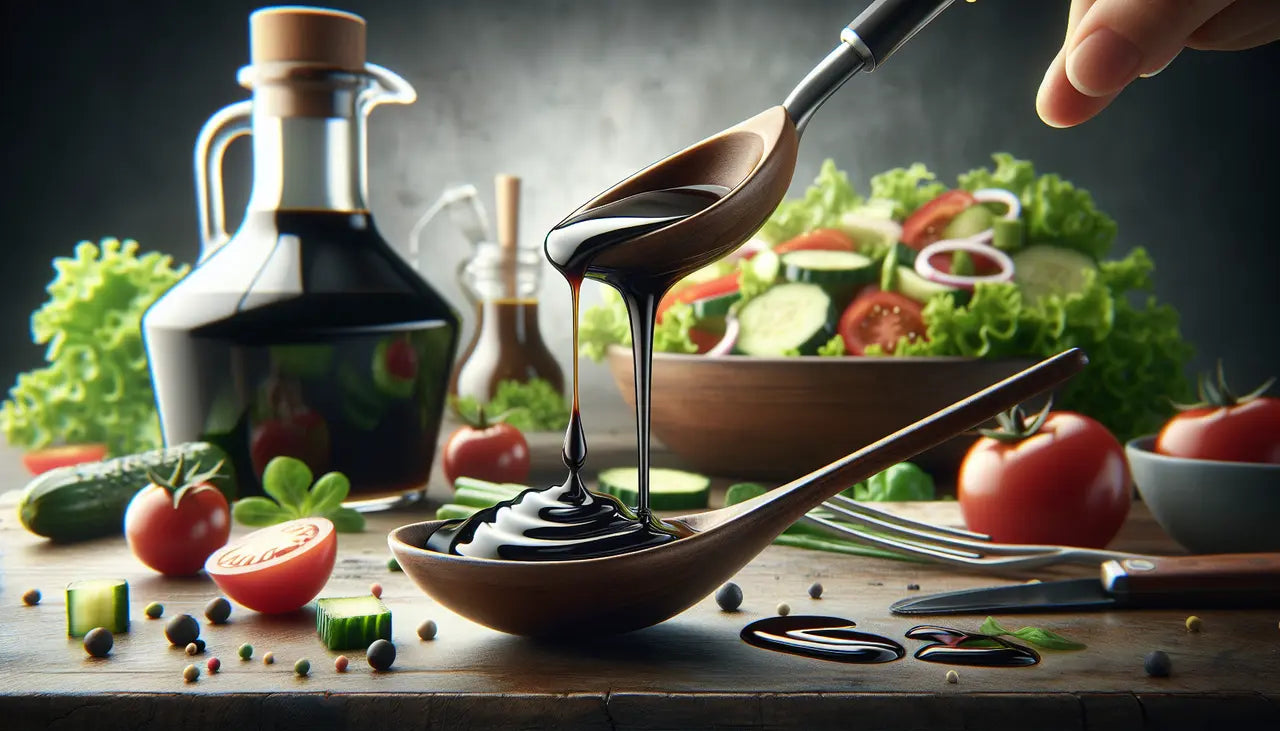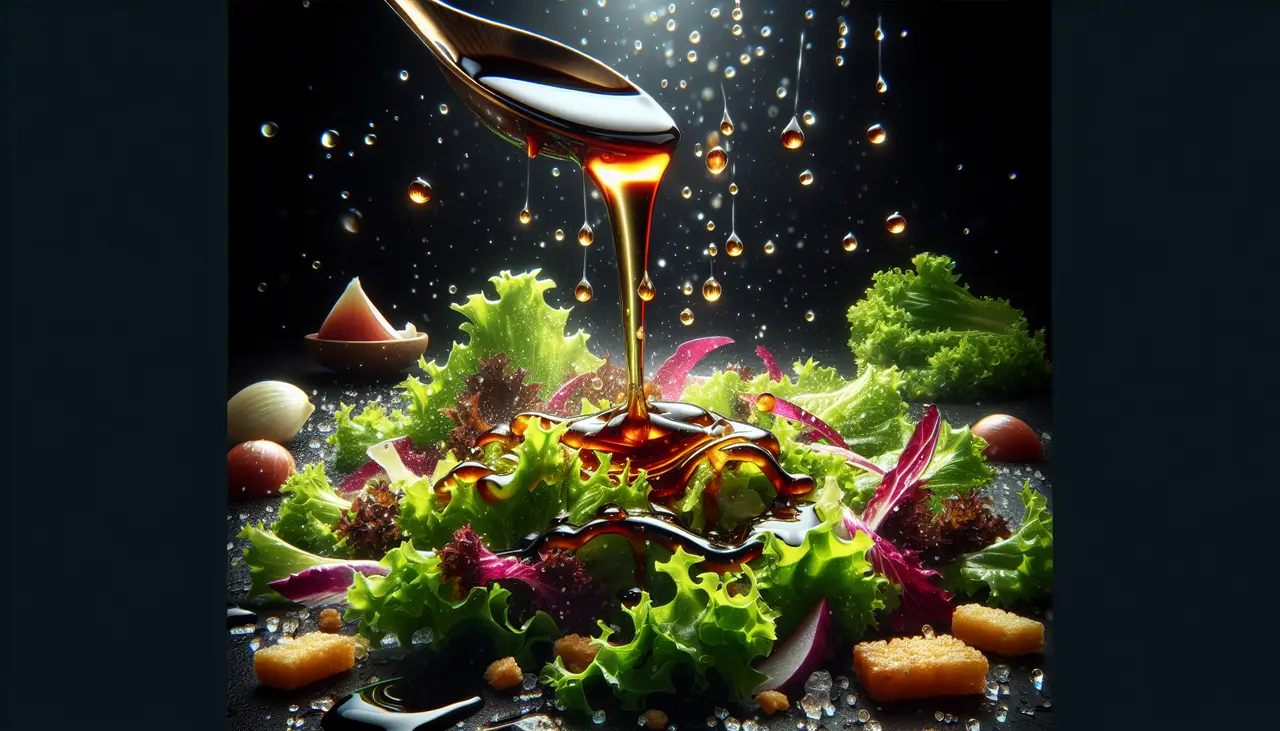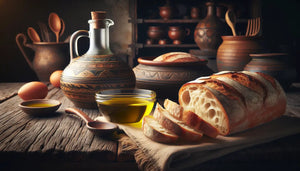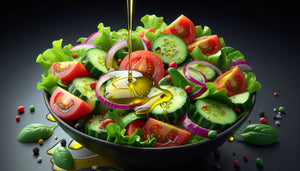Introduction to Gourmet Balsamic Vinegar
Gourmet balsamic vinegar is more than just a condiment. Originating from Italy, specifically the regions of Modena and Reggio Emilia, this vinegar has been cherished for its unique flavor and versatility in cooking for centuries. Traditionally made from the cooked must of Trebbiano or Lambrusco grapes, the production process of true balsamic vinegar involves aging it in a series of wooden barrels over many years, even decades. The result? A complex, sweet, and tangy vinegar that can elevate the taste of any dish, from salads to desserts and even drinks.
But not all balsamic vinegars are created equal. In the market, you will find a range from the very expensive “Aceto Balsamico Tradizionale,” aged for at least 12 years and protected by strict regulations, to more affordable options often labeled as “Balsamic Vinegar of Modena.” These are made with a mix of wine vinegar and some percentage of actual balsamic vinegar, providing a simpler, yet still tasty, alternative.
The world of gourmet balsamic vinegar doesn’t stop at traditional flavors. Innovators in the culinary field have introduced an array of infused balsamics, adding ingredients like fig, cherry, and even chocolate, opening up a whole new spectrum of culinary possibilities. Whether drizzled over roasted vegetables, mixed into vinaigrettes, used as a glaze for meats, or even poured over ice cream, gourmet balsamic vinegar promises to add a touch of luxury and depth of flavor to your dishes.
The Origins and Traditional Production of Balsamic Vinegar
Balsamic vinegar comes straight from the heart of Italy, mainly the regions of Modena and Reggio Emilia, where it’s been a staple for centuries. Traditionally, it’s made from Trebbiano grape must, which is freshly crushed grape juice with all the skins, seeds, and stems. The process is quite the art form. First, the must is cooked down to create a concentrated syrup. Then, it’s aged in a series of wooden barrels, each type of wood adding its own unique flavor to the vinegar. This aging process can last from 12 years to an astounding 25 years or more for the finest grades, known as DOP Traditional Balsamic Vinegar of Modena or Reggio Emilia. This meticulous method produces a rich, thick, and complexly flavored balsamic vinegar, quite different from the everyday varieties you might find at your local grocery store. The dedication to tradition and quality makes true balsamic vinegar an indulgence worth exploring.
Exploring the Variety of Flavors in Gourmet Balsamic Vinegar
Gourmet balsamic vinegar isn’t just one flavor. It’s a world of tastes. Think beyond the basic. We’ve got traditional, aged like fine wine, offering deep, complex profiles. Then, there’s innovative flavors, where creativity meets culinary. Imagine balsamic with infusions of fruits like fig, cherry, or raspberry for a sweet twist. Or, herbs and spices like rosemary or black pepper that bring a savory edge. The basics? They start off sharp and sweet. Age them, and you get a rich, mellow symphony of flavors. Innovation doesn’t stop. From applewood smoked to chocolate-infused, these vinegars add a pop of flavor to salads, meats, or even desserts. Dive into the variety, and let your taste buds explore.
The Aging Process: How Time Enhances Flavor
The secret behind the rich, complex flavor of gourmet balsamic vinegar? Time. It’s all about the aging process. Traditional balsamic vinegar, or “Aceto Balsamico Tradizionale,” takes a journey through time, sometimes aging for decades. This isn’t just waiting around; it’s a careful, deliberate process that transforms simple grape must into a deep, flavorful elixir. Here’s how it works: after the grape must is cooked down, it’s transferred to wooden barrels. Over years, it slowly ages, moving from barrel to barrel, usually made of different woods like oak, chestnut, cherry, ash, and mulberry. Each wood type adds its unique flavors to the vinegar. Through this journey, the vinegar not only thickens and concentrates but also picks up flavors from the barrels, melding them into the complex, tangy, and sweet product we adore. The age of balsamic vinegar can range significantly – from the minimum 12 years to over 25 years for the really special stuff. Remember, the longer it ages, the more intense and refined the flavors. So, when you taste a drop of aged balsamic vinegar, you’re not just tasting a condiment. You’re experiencing the essence of time and tradition.
Innovation in Balsamic Vinegar: Beyond the Traditional
Gone are the days when balsamic vinegar was just a dark, rich condiment for salads and strawberries. Today, innovation is key in the world of gourmet balsamic vinegar, pushing beyond traditional boundaries to introduce a spectrum of flavors. Imagine balsamic infused with fruits like fig, cherry, or raspberry, offering a sweet twist that elevates desserts and mains alike. Then there are even more adventurous blends, incorporating spices, herbs, or even a hint of chocolate or truffle, perfect for those looking to add an unexpected depth to their dishes. This innovation isn’t just about flavor. It’s about experimenting with aging processes too. While classic balsamic vinegar ages for years, newer methods are being explored to speed up this process or alter the taste in unique ways. So, next time you’re in the market for balsamic vinegar, think beyond the traditional. These inventive options can turn an ordinary meal into a gourmet experience with just a drizzle.
Pairing Tips: How to Match Balsamic Vinegar with Food
When it comes down to pairing balsamic vinegar with food, the key is to think about balance. The rich, sweet, and tangy flavor of balsamic vinegar can turn a simple dish into something extraordinary. Here’s how to do it right. Salads are a no-brainer. Mix balsamic with olive oil for a classic vinaigrette. It’ll give your greens a punch. For cheese, aged balsamic vinegar works like magic, especially with Parmesan or goat cheese. The combination is out of this world. If you’re into grilled meats, a drizzle of balsamic vinegar before serving can enhance the flavors. It’s especially good with beef and chicken. Fruits like strawberries and peaches get a new life with balsamic. Just a dash and you’ve got a dessert that sings. Lastly, don’t limit yourself. Experiment. The goal is to enjoy your food. Remember, there are no hard rules. If it tastes good to you, you’re doing it right.
The Health Benefits of Incorporating Balsamic Vinegar into Your Diet
Balsamic vinegar isn’t just for dressing up salads or adding a splash of flavor to dishes; it’s a health powerhouse in a bottle. First off, it’s low in calories. Just a tablespoon of balsamic vinegar can add a burst of flavor to your meal without packing on the pounds. It’s a guilt-free way to make your food tastier. Plus, it’s good for your gut. Balsamic vinegar contains antioxidants that fight against cell damage, improve the body’s immune system, and make your gut healthier by promoting good bacteria. This vinegar also helps you feel full longer, which can be a game-changer if you’re trying to watch your weight or cut back on snacking. And let’s talk about blood sugar; balsamic vinegar can help keep your glucose levels in check. Adding it to your meals can slow down the absorption of sugar, which is a big deal for maintaining steady blood sugar levels. So, incorporating balsamic vinegar into your diet is more than just boosting food flavor. It’s about embracing a simple, tasty way to support your overall health.
How to Spot Authentic Gourmet Balsamic Vinegar
When shopping for genuine gourmet balsamic vinegar, knowing what to look for is crucial. First off, check the label for “Aceto Balsamico Tradizionale” followed by the origin, either Modena or Reggio Emilia, Italy. These are protected names, meaning the product follows strict traditional methods. Another key indicator is the aging period. Authentic balsamic vinegar is aged for a minimum of 12 years, with some even reaching up to 25 years for extra vecchio (very old) quality. The packaging also gives clues; traditional balsamic vinegar comes in a unique bottle with a seal from the Consortium, the organization that ensures its authenticity and quality. Lastly, price often reflects quality. Real gourmet balsamic vinegar will not be cheap due to its lengthy and detailed production process. If it’s too good to be true in terms of price, it probably isn’t the real deal.
DIY Balsamic Reductions and Infusions at Home
Making balsamic reductions and infusions at home is simpler than you think, and it allows you to put a personalized spin on your dishes. Start with a decent quality balsamic vinegar; it doesn’t have to break the bank but avoid the cheapest on the shelf. To make a reduction, pour the vinegar into a small pot and simmer it over low heat. Stir occasionally until it thickens to your liking, usually when it coats the back of a spoon. This thick, syrupy delight elevates desserts, salads, and meats. For infusions, add herbs, fruits, or spices to the vinegar before you reduce it. Imagine a strawberry balsamic reduction drizzled over vanilla ice cream or a rosemary infusion adding depth to your salad dressing. The key is to experiment. Start with small batches, taste as you go, and adjust according to your palate. Whether you’re prepping for a fancy meal or jazzing up a weeknight dinner, homemade balsamic creations are sure to impress.
Conclusion: The Endless Possibilities of Gourmet Balsamic Vinegar
Gourmet balsamic vinegar isn’t just a dressing; it’s a journey through taste, tradition, and innovation. Whether you drizzle it over salads, mix it into marinades, or add a dash to desserts, its versatility is unmatched. From the classic, age-old tradition of Modena to the inventive infusions of fruits and spices, there’s a flavor profile for every palate. Embracing gourmet balsamic vinegar means opening your kitchen to a world where every meal can be transformed into a culinary masterpiece. So, experiment, taste, and let your culinary adventures begin. The possibilities, after all, are endless.







